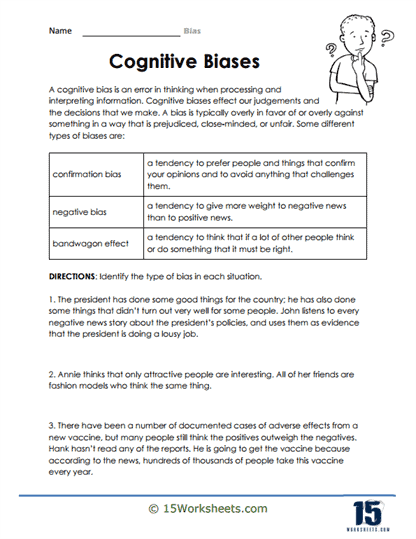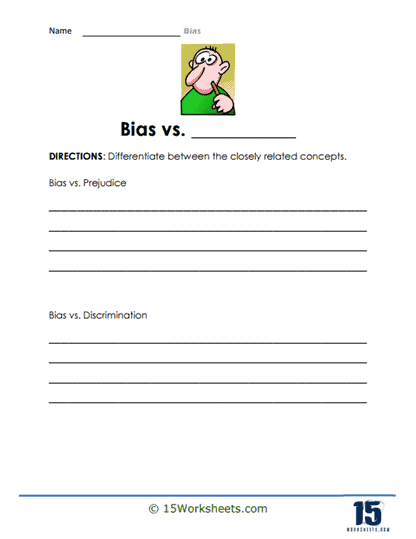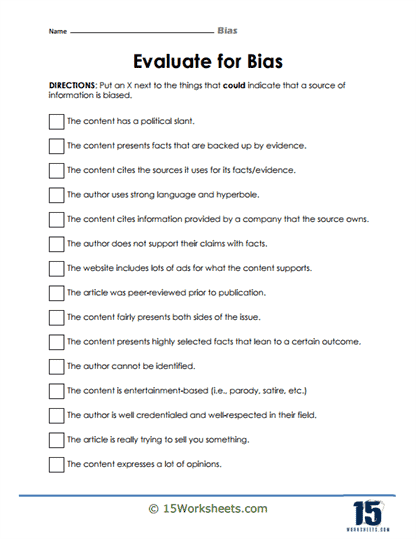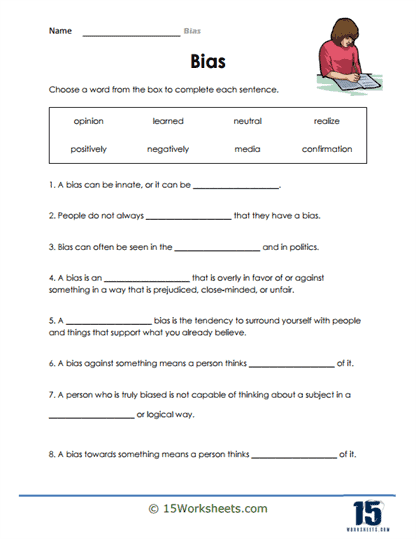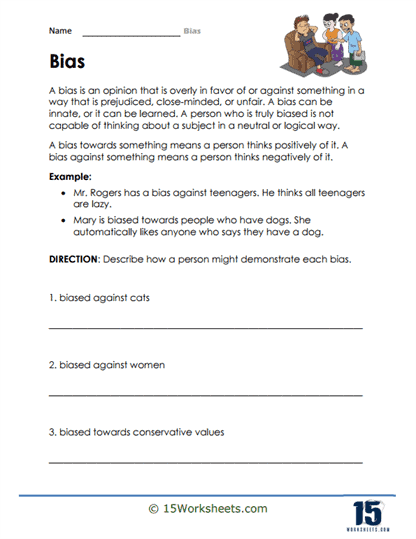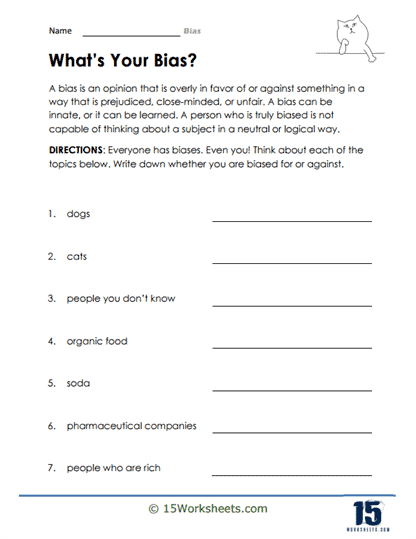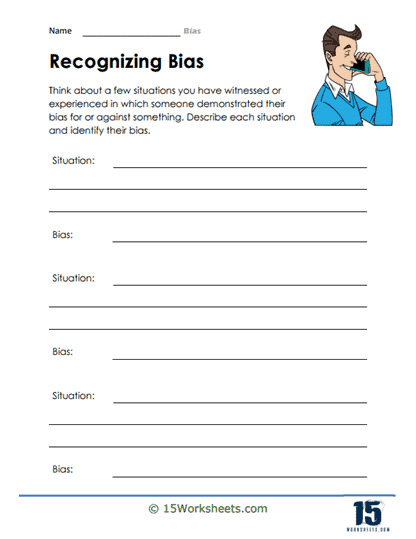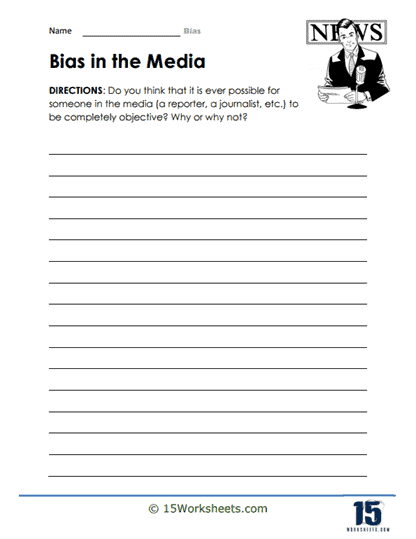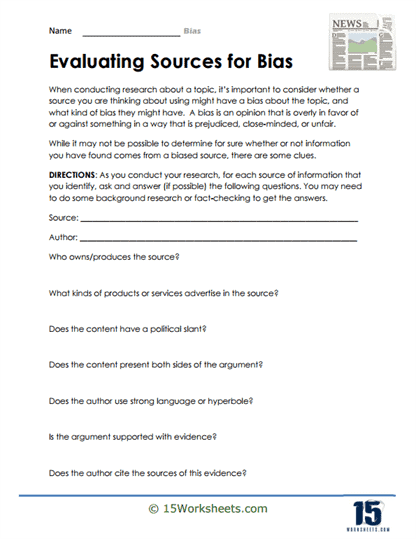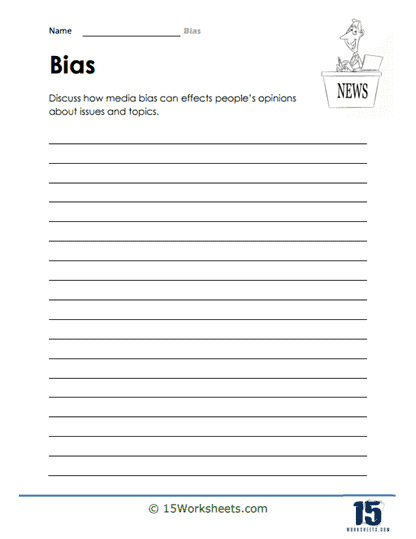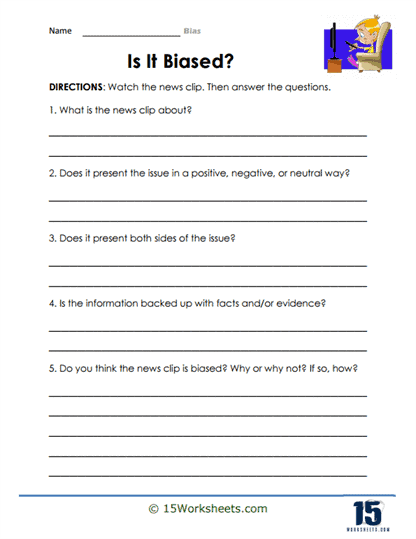Bias Worksheets
All About These 15 Worksheets
Bias, the inclination or prejudice in favor of or against one person, group, or thing, often without rational justification, is a pervasive aspect of human cognition and communication. Understanding and recognizing bias is crucial for students as it fosters critical thinking, empathy, and effective communication skills.
In a world where diversity, equity, and inclusivity are of paramount importance, students must develop the ability to identify, analyze, and navigate bias in their personal lives and society at large. To empower students with the knowledge of bias and its multifaceted implications, we proudly present a collection of 15 worksheets. These worksheets are meticulously designed to provide students with structured and engaging opportunities to explore, question, and address bias.
Bias worksheets will help students understand the concept of bias and develop critical thinking skills to identify and analyze bias in various forms of media, texts, and sources. These worksheets aim to promote media literacy and encourage students to think critically about the information they encounter.
Students will be presented with examples of articles, news reports, or other media content that exhibit bias. The worksheets may include questions or tasks that require students to identify instances of bias and highlight specific language, tone, or framing that indicate bias. The goal is to provide students with the tools to recognize, analyze, and critically engage with biased information they encounter in their studies and daily lives.
Bias In Literature
Bias in literature refers to an author’s subjective viewpoint or inclination towards a particular perspective, ideology, group, or individual. This perspective can consciously or unconsciously shape the narrative of a text, influencing its themes, characters, and plots. Bias can be employed to construct a specific narrative, evoke certain emotions, convey a particular message, or even challenge the reader’s existing views.
Characteristics Of Bias
The main defining feature of bias is its partiality. It presents a one-sided perspective on an issue or subject. Rather than giving an objective or balanced view of events, characters, or themes, bias can lead to the prioritization of one perspective over others. Bias is neither inherently negative nor positive, but its recognition and understanding are vital for nuanced interpretation and critical analysis of a text.
The characteristics of bias in literature include:
Selective Presentation – Bias can lead to the selective presentation of events, where some incidents are highlighted while others are downplayed or ignored. This creates a specific interpretation of the situation.
Subjective Character Portrayal – Bias can also affect the portrayal of characters. Characters that align with the author’s perspective may be portrayed favorably, while those who oppose it may be depicted negatively.
Manipulation of Reader’s Emotions – Bias often manipulates the reader’s emotions. By presenting events or characters in a certain light, authors can evoke specific emotional responses from the reader.
Promotion of a Particular Ideology – Bias can serve to promote a specific ideology, belief, or perspective, subtly or overtly weaving it into the narrative.
Authors use bias for various reasons. It can be used to create empathy for certain characters, drive a narrative, or make a statement on societal or political issues. It’s important to note that every author brings their own experiences, beliefs, and perspectives to their writing, which can naturally introduce a level of bias.
Examples of Bias in Literature
Consider the following examples of bias in literature:
“To Kill a Mockingbird” by Harper Lee – The novel is narrated from the perspective of Scout, a young girl who adores her father, Atticus Finch. Because of her love for her father, Atticus is portrayed as a wise, moral, and heroic figure throughout the novel. This bias in narration may cause the reader to overlook any flaws in Atticus’ character or actions, and view him as a paragon of virtue.
“Pride and Prejudice” by Jane Austen – The novel is told primarily through Elizabeth Bennet’s perspective, causing a bias in how other characters are perceived. Mr. Darcy, initially presented as arrogant and cold, is seen in a more favorable light as Elizabeth’s bias towards him changes throughout the novel. Elizabeth’s changing biases affect the reader’s perception of Darcy’s character.
“Animal Farm” by George Orwell – This novel serves as a critique of totalitarian regimes, specifically referencing the Soviet Union under Stalin. Orwell’s bias against these regimes is evident in his portrayal of the pigs, who represent the oppressive ruling class. This clear political bias helps convey Orwell’s critique of totalitarianism.
The effect of bias on the reader can be substantial. Bias can shape the reader’s perception of characters, events, and themes in the text, influencing their emotional responses and interpretations. Recognizing bias is a crucial part of literary analysis, helping the reader understand the author’s intent and encouraging critical thinking about the text’s messages and themes. It is also crucial for the reader’s self-awareness, prompting them to consider their own biases and how these might influence their interpretation of the text. In this way, understanding bias can open up deeper, more nuanced engagement with literature.
The Importance of Understanding Bias
Understanding bias and its various manifestations is of great importance for several reasons:
- Critical Thinking: Recognizing bias encourages students to think critically about the information they encounter, helping them discern between facts and opinions.
- Empathy and Inclusivity: Awareness of bias fosters empathy by promoting understanding of different perspectives and experiences. It also encourages inclusivity and respect for diversity.
- Media Literacy: In the age of information, students need the skills to navigate media and content critically, identifying potential bias and misinformation.
- Effective Communication: Recognizing and addressing bias enhances students’ communication skills, allowing them to engage in respectful and constructive dialogues.
This collection of Bias worksheetsis a valuable resource for educators and parents committed to nurturing critical thinking, empathy, and effective communication skills in students. Proficiency in recognizing, analyzing, and addressing bias equips individuals with the tools to navigate an increasingly complex and diverse world with sensitivity and respect. This collection is an investment in their future success, ensuring they have the skills to engage in informed, empathetic, and inclusive conversations, challenge stereotypes, and contribute positively to a society that values diversity and equity.
Embrace these worksheets today, and watch your students become thoughtful, empathetic, and discerning individuals who can unmask bias, embrace diverse perspectives, and work towards a more inclusive and equitable future.



